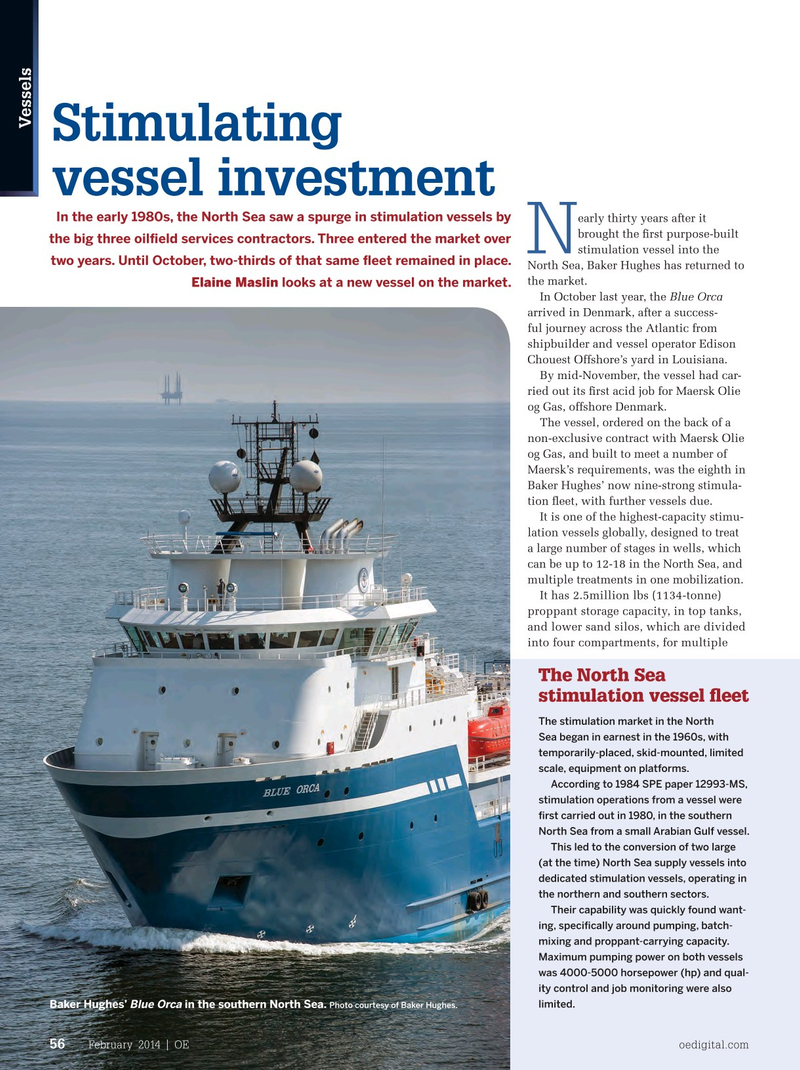
Page 54: of Offshore Engineer Magazine (Feb/Mar 2014)
Read this page in Pdf, Flash or Html5 edition of Feb/Mar 2014 Offshore Engineer Magazine
Vessels
Stimulating vessel investment
In the early 1980s, the North Sea saw a spurge in stimulation vessels by early thirty years after it brought the frst purpose-built the big three oilfeld services contractors. Three entered the market over
N stimulation vessel into the two years. Until October, two-thirds of that same feet remained in place.
North Sea, Baker Hughes has returned to the market.
Elaine Maslin looks at a new vessel on the market.
In October last year, the Blue Orca arrived in Denmark, after a success- ful journey across the Atlantic from shipbuilder and vessel operator Edison
Chouest Offshore’s yard in Louisiana.
By mid-November, the vessel had car- ried out its frst acid job for Maersk Olie og Gas, offshore Denmark.
The vessel, ordered on the back of a non-exclusive contract with Maersk Olie og Gas, and built to meet a number of
Maersk’s requirements, was the eighth in
Baker Hughes’ now nine-strong stimula- tion feet, with further vessels due.
It is one of the highest-capacity stimu- lation vessels globally, designed to treat a large number of stages in wells, which can be up to 12-18 in the North Sea, and multiple treatments in one mobilization.
It has 2.5million lbs (1134-tonne) proppant storage capacity, in top tanks, and lower sand silos, which are divided into four compartments, for multiple
The North Sea stimulation vessel feet
The stimulation market in the North
Sea began in earnest in the 1960s, with temporarily-placed, skid-mounted, limited scale, equipment on platforms.
According to 1984 SPE paper 12993-MS, stimulation operations from a vessel were frst carried out in 1980, in the southern
North Sea from a small Arabian Gulf vessel.
This led to the conversion of two large (at the time) North Sea supply vessels into dedicated stimulation vessels, operating in the northern and southern sectors.
Their capability was quickly found want- ing, specifcally around pumping, batch- mixing and proppant-carrying capacity.
Maximum pumping power on both vessels was 4000-5000 horsepower (hp) and qual- ity control and job monitoring were also limited.
Baker Hughes’ in the southern North Sea. Blue Orca Photo courtesy of Baker Hughes.
February 2014 | OE oedigital.com 56 056_OE0214_vessels1.indd 56 1/20/14 9:38 PM

 53
53

 55
55